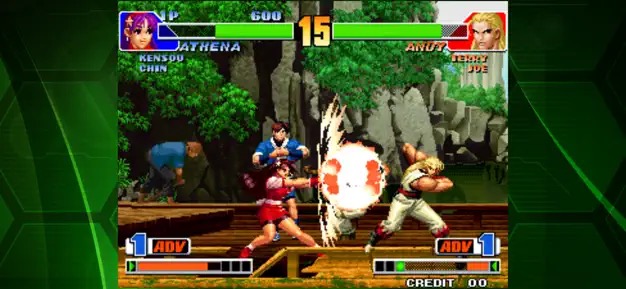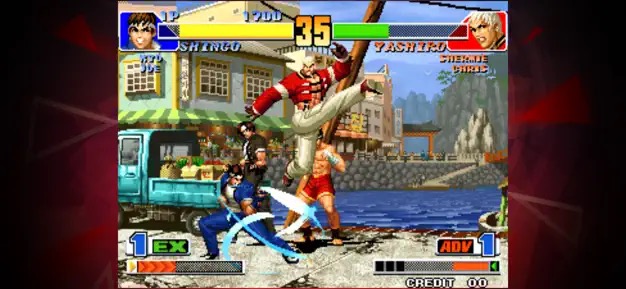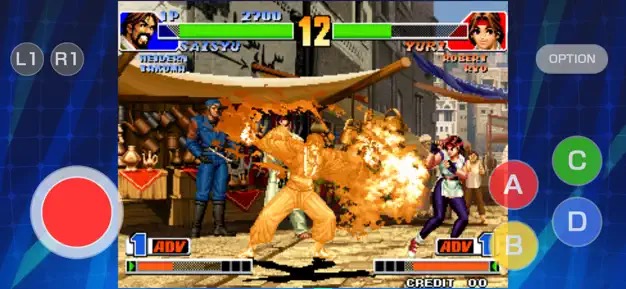 I’ve wondered if and when this would happen, but now the day has come. For those who haven’t followed the state of SNK on mobile over the years, the Arcade Archives aren’t the first time the former arcade giant has reissued its classics on iOS. Around a decade ago, it did several releases with Dotemu. Each one was hand-tailored to an extent and as such there were only a handful of titles released. Mainly the big hits. That of course included one of the more popular entries in the King of Fighters series, The King of Fighters ’98 ($2.99). Hamster has up until now intentionally been steering clear of those titles, but we finally have our first overlap with KOF ’98 ($3.99). So how does the new compared with the old? Let’s find out!
I’ve wondered if and when this would happen, but now the day has come. For those who haven’t followed the state of SNK on mobile over the years, the Arcade Archives aren’t the first time the former arcade giant has reissued its classics on iOS. Around a decade ago, it did several releases with Dotemu. Each one was hand-tailored to an extent and as such there were only a handful of titles released. Mainly the big hits. That of course included one of the more popular entries in the King of Fighters series, The King of Fighters ’98 ($2.99). Hamster has up until now intentionally been steering clear of those titles, but we finally have our first overlap with KOF ’98 ($3.99). So how does the new compared with the old? Let’s find out!
I actually wrote the TouchArcade review for The King of Fighters ’98 (Dotemu version) nine years ago. I’m going to borrow a bit from myself to introduce the game before we start making comparisons. Shaun of 2014, take it away!

“The King of Fighters ’98 represents the first “Dream Match" installment of the series, where the story is set aside so that old and new characters can appear alongside each other, even if they’re dead or it doesn’t fit the plot. As such, with a few notable exceptions, this game has every character from King of Fighters ’94 through King of Fighters ’97, rounding out the roster to an impressive 38 characters. If that’s not enough for you, nine of the characters even have alternate versions that reflect an earlier incarnation. What makes that number of characters even more impressive is how well-balanced the game is. While some characters, like Iori or Kyo, definitely outshine others, such as Andy or Billy, the gap between the best and the worst is smaller than just about any other fighting game with such a large list of playables.
As usual for the series, you pick a team of three characters and fight it out against other teams of three. This installment was from the era where you couldn’t tag in and out freely, instead choosing the order in which your fighters will appear. If you finish off your opponent, your character’s health will get restored a little and the next fresh opponent will face you in the next round. Eliminate the whole opposing team and you win. KOF ’98 carries forward the Advanced and Extra modes from KOF ’97, offering different styles of building and using your super meter. Aside from the roster changes and balancing, the gameplay isn’t much different from the previous year’s version, but that’s pretty typical for a fighting game sequel. There’s no story, and the boss this time around is Omega Rugal, an SNK boss if there ever was one."

Alright, that seems adequate. Odds are good that if you’re reading this, you probably already have a decent idea of what The King of Fighters ’98 is. You might even own that previous version. So let’s get to the proper meat and see how Hamster’s KOF ’98 fares against Dotemu’s The King of Fighters ’98. First, I will say that the emulation quality is excellent on both. Once you’re in the game and playing, there’s very little to distinguish the two. The sound is a bit better on Hamster’s version to my ear, but only a bit. Dotemu’s version skips the attract mode and title screen, so Hamster’s version does offer a more authentic arcade experience. Both versions support external controllers, and that is the recommended way to play.
That will bring us to the first major difference: the touch controls. Dotemu’s version is customized to an extent, with context-specific touch buttons, an SP button for easy activation of special moves, and a choice between the standard four button layout or six buttons with some button combos. You can adjust the size and opacity of these controls, but since this is a fairly old app even the maximum size is a bit on the small side. You can’t move them around, either. Hamster’s version uses the same stock touch controls seen in its other Arcade Archives releases. There are no special buttons or combo buttons here, but you can move around the existing virtual buttons, chance their opacity and size, adjust the diagonal sensitivity, and even choose whether the input on the stick will be digital or analog. I’m not going to lie: Dotemu’s SP button makes it easier to bust out moves with touch controls, but Hamster wins in every other regard.

Indeed, broadly speaking, Hamster gets the win in options. Hamster’s version allows you to tweak a few specific gameplay settings where Dotemu’s just allows you change the difficulty level. Hamster allows you to fully remap controls; Dotemu’s does not. In terms of video settings, Hamster allows you to change the screen layout and orientation, turn the wallpaper on or off, whether you want to display “off-screen" graphics (things that the bezel of most displays would have hidden back in the day, and gives you a wild degree of customizability in terms of applying filters to the visuals. Dotemu lets you choose whether you want a smoothing filter on or off, and if you want scanlines. Hamster offers sound setting options; Dotemu does not. You can make a save state and resume later in Hamster’s version, but in Dotemu’s you have to start over every time. Hamster is the clear winner here.
The extras are where things get a little messier. Hamster offers its usual selection. You can pick between the Japanese and International versions in standard mode, and the standard Score Attack and timed Caravan modes are here. Each mode has its own online leaderboard to compete on. Multiplayer is available, but only on the same device using multiple external controllers. Over on Dotemu’s side, you have a standard single-player mode using the International version of the game, a training mode that gives you a CPU dummy to beat up on, and support for multiplayer via local wireless. That last feature is a welcome one, as I personally feel it’s easier to set up matches with another person that way. Neither one supports online multiplayer, unfortunately. I’d give Dotemu the edge here, though it’s not a dramatic win.

The last difference is the price. This new version costs a dollar more than Dotemu’s old one. It’s just a dollar, but it’s still a dollar. That will get you at least a couple of slices of bread these days. Looking at the overall picture, which version is best is going to depend on your situation. The small virtual controls on Dotemu’s version really hurt its value if you’re not playing with an external controller. The training mode and more convenient multiplayer are great extras, and the game runs just as well. Hamster’s standard Arcade Archives features certainly give you more to play around with, but things like the Caravan mode aren’t as well-suited to fighters as they are to, say, shoot-em-ups. Multiplayer is pretty awkward to get going here, too.
If you already own the Dotemu version of The King of Fighters ’98, this new version doesn’t make a very compelling case for itself. If you don’t have either of them and are trying to choose, it’s a hard call. This one costs more and has more options and extras, but the Dotemu one has a couple of nice features you won’t find in this Arcade Archives release. I’d probably recommend this new one simply because it has a lower chance of being deprecated, but I think it’s otherwise a hard call. KOF ’98 is a great game that, like other arcade fighters, isn’t necessarily the best fit for mobile. It was dicey to recommend once, and I’m not sure I can muster much enthusiasm for a second dip.
from TouchArcade https://ift.tt/AXoRKdL



0 Comments